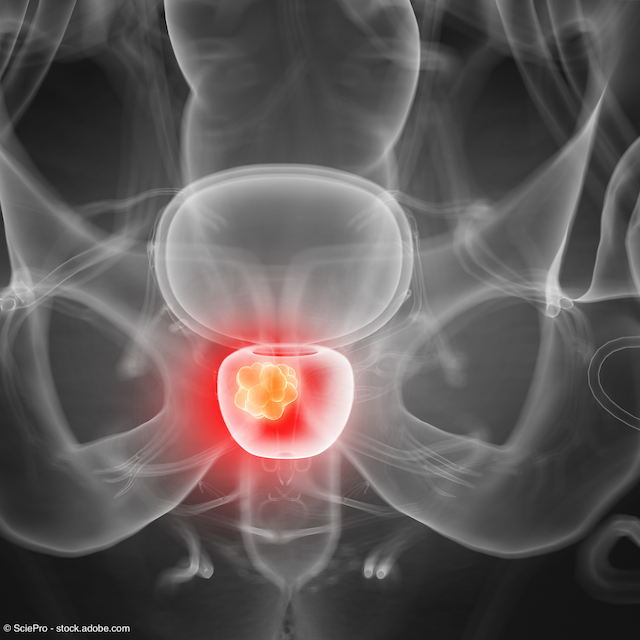- Benign Prostatic Hyperplasia
- Hormone Therapy
- Genomic Testing
- Next-Generation Imaging
- UTUC
- OAB and Incontinence
- Genitourinary Cancers
- Kidney Cancer
- Men's Health
- Pediatrics
- Female Urology
- Sexual Dysfunction
- Kidney Stones
- Urologic Surgery
- Bladder Cancer
- Benign Conditions
- Prostate Cancer
MRI-targeted prostate biopsy results in less upgrading, more downgrading at RP
“Combined MRI-targeted and systematic biopsies were nearly twice as likely to result in downgraded pathology at prostatectomy compared [with] systematic biopsies," says Ilon C. Weinstein.
Lower rates of pathologic upgrading were observed among biopsy cores that underwent MRI targeting at radical prostatectomy compared with those that underwent systematic biopsy alone, according to data published in European Urology Oncology.1
The rate of upgrading among MRI-targeted biopsy cases was 32%, compared with 42% among systematic biopsy cases.

“MRI-targeted biopsy is quickly becoming the standard of care for prostate cancer diagnosis. This is because randomized trials have shown that when we use MRI, our biopsies find more high-grade cancer and less low-grade cancer,” explained senior author Jonathan E. Shoag, MD, in correspondence with Urology Times®. “Intuitively, we think that's probably a good thing, but it's hard to be sure. This is because the grade on biopsy doesn't necessarily translate into ‘clinical significance.’ For instance, MRI may be good at finding small high-grade areas, that are not actually important for a patient’s prognosis, that we wouldn't have found before. In that regard, a patient who previously we would have considered watching based on their biopsy pathology, may now have treatment that they don't benefit from because of ‘grade inflation’ from using the MRI to find their cancer. In that light, it's surprising that we've accepted biopsy pathology as essentially the sole end point for all our MRI targeted biopsy trials.” Shoag is a urologist at University Hospitals and an assistant professor of urology at Case Western Reserve University in Cleveland, Ohio.
For the study, the investigators sought to assess the effect of MRI-targeted versus systematic and combined biopsies on pathological upgrading and downgrading at the time of radical prostatectomy. Data from PubMed MEDLINE and Cochrane Library were collected on 6638 men for meta-analyses.
“One way to get at this question is to look at grade changes between biopsy and prostatectomy pathology as a way to better understand the oncologic importance of the cancers we're finding… We did this by meta-analysis of all the existing trials of MRI-targeted biopsy where we had information on prostatectomy pathology—and we actually found that there is a significant tradeoff with using MRI-targeted and combined prostate biopsies, with less upgrading but more downgrading at prostatectomy,” said lead author Ilon C. Weinstein in correspondence with Urology Times. Weinstein is a third-year medical student at Case Western Reserve University School of Medicine.
Specifically, the rate of upgrading among MRI-targeted biopsy cases was 32%, compared with 42% among systematic biopsy cases (odds ratio [OR], .70, 95% CI .63–.77, P < .001, τ2 = 0.32, P < .001). For combined targeted and systematic biopsies, the rate of upgrading was 27% (OR, .50, 95% CI .45–.55, p < 0.01, τ2 = 0.38, P < .001).
Further, the rate of downgrading among MRI-targeted cores was 12.1%, compared with 10.7% of systematic cores. For combined targeted and systematic biopsies, the rate of downgrading was 18.6% (OR, 1.95, 95% CI 1.68–2.27, P < .01, τ2 = .03, P < .001).
“Combined MRI-targeted and systematic biopsies were nearly twice as likely to result in downgraded pathology at prostatectomy compared [with] systematic biopsies. In clinical practice, significant downgrading is concerning as patients may have been unnecessarily treated and could have potentially benefited from less aggressive therapies or surveillance,” said Weinstein.
The investigators also compared pathologic concordance between biopsy and radical prostatectomy staging, showing agreement in 55.2% of targeted biopsy cases, compared with 45.4% of systematic biopsy cases (OR, 1.35, 95% CI 1.23–1.49, P < .001, τ2 = .42, P < .001). Adding MRI targeting to systematic biopsies showed greater concordance compared with systematic biopsy alone (OR, 1.43, 95% CI 1.29–1.59, P < .001, τ2 = .31, P < .001).
Weinstein concluded, “Because we did this by meta-analysis, we didn't have the granularity to understand how this grade inflation would have [affected] management, only that it seems to be occurring, and we hope future work will help us understand the tradeoffs more precisely.”
Reference
1. Weinstein IC, Wu X, Hill A, et al. Impact of magnetic resonance imaging targeting on pathologic upgrading and downgrading at prostatectomy: A systematic review and meta-analysis. Eur Urol Oncol. Published online May 24, 2023. Accessed June 13, 2023. doi:10.1016/j.euo.2023.04.004
Cell-cycle risk score is predictive of ADT benefit in prostate cancer
May 17th 2024"Prolaris precisely describes the difference in metastasis outcomes for men receiving monotherapy (RT) vs multimodal therapy (RT+ADT), and further tells me precisely what the risk of death is for a man on surveillance," says Jonathan D. Tward, MD, PhD.
